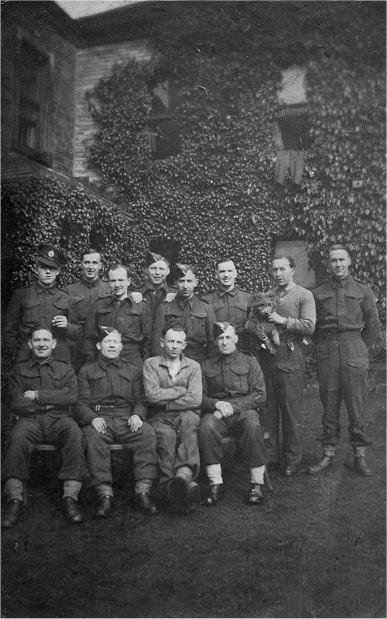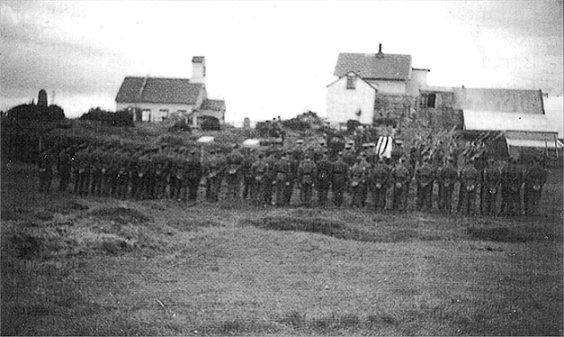12th Battalion Worcestershire Regiment (1940-1942)
The 12th. Battalion Worcestershire Regiment was raised again in Burton on the 1st June 1940 it was commanded by Lieut.-Colonel A. P. Watkins. The Battalion was raised as the 50th (Holding) Battalion, the permanent staff coming from the 1st Militia Training Group at Dover and from the Worcestershire Company of the 8th Holding Battalion at Crewe. Three companies were raised from men called up from civil life, a fourth company being formed from “old soldiers” and men of Worcestershire returning from Dunkirk. Immediately after Dunkirk the Battalion housed and re-clothed some 250 officers and men of the B.E.F.
During August and September 1940 ‘D’ Company of the battalion were involved in guarding a camp of French sailors at Trentham Park, outside Stoke. It was not until 9th October 1940 that the Battalion was designated 12th Battalion The Worcestershire Regiment, and became a Rifle Battalion. From Burton a move was made to Dudley on 15th October 1940, yet another transfer to Llanelly taking place on 25th February, 1941. The three months at Dudley passed quickly, for the hospitality of the town to a battalion of their county regiment was phenomenal. At this time the raids on the Midlands were increasing and the men were constantly busy in Birmingham clearing the debris. At Llanelly the Battalion’s chief concern was the defence of the beaches, the old machine gunners coming into their own with an issue to beach companies of the Vickers machine gun. The Battalion was scattered over a wide area, with 'C' Company on Pembrey beach near a large R.A.F. fighter station, 'D' Company at Ashburnham beaches, and the other two companies in the town, the whole area stretching a length of about fifteen miles. On 4th June 1941 the Battalion sailed from Greenock for Iceland. On 8th June the Battalion disembarked at Reykjavik, the capital of the island, and by 13th June it was encamped in Reykjaskoli, with H.Q. and two companies billeted in the school and in tents, the remaining two companies being scattered, 'D' Company at Blonduös and 'B' Company at Borganes, a hundred miles separating the two. The school was most fortunately found to be heated very effectively by water from hot springs from the mountainside near by. At the time 49th West Riding Division (Territorials) held Iceland, and the protection of the north-west sector, an area one hundred miles in length, fell to the Battalion, which had a battery under command. The stretch of sea on which Blonduös is situated is called the “Hunafloi,” “Huna” being the Icelandic for “Bear.” A bear was known once to have floated ashore at Blonduös. The Iceland landscape is not exciting. There are no trees and very few bushes or flowers: and although the 49th Division took the polar bear on their badge, no polar bears were ever seen on the island! Occasional E.N.S.A. parties and the 16 mm. films of the Army cinema organization were welcome high-lights in long periods of monotony. Away from Headquarters, 'D' Company at Blonduös perhaps enjoyed a slightly more varied programme than their companions, 'B' Company at Borganes. Blonduös was the staging camp between Reykjavik and Akureyri, the latter being the only port in the north of the island. At Company Headquarters a visitors’ book recorded the passage of travellers and registered about a hundred signatures in three months. |
Men of the 12th Battalion who served in Iceland (1941-42) |
Blonduös was the scene of an episode, small enough in the general perspective of the war, yet sufficiently sensational to give an isolated company of 12th Worcestershire something to discuss for a short period in their uneventful era. A small Norwegian vessel one day suddenly appeared, which had sailed from Spitzbergen using only a child’s atlas and pocket compass. The captain brought a story for the G.O.C., Iceland, about the German intentions in regard to the Spitzbergen coal. He was passed on from Akureyri to Reykjavik by plane, and, whether through his initiative and courage or whether through other intelligence available, a month later Canadian troops landed at Spitzbergen and destroyed the coal dumps.
Burial of Colour-Sergeant Arthur William Church |
Paradoxically, with slender chances of enemy interference, the training facilities were excellent and musketry enthusiasts would have found the fulfilment of their ambitions in the opportunities the country offered for field firing. To encourage initiative reconnaissance parties went off for days at a time and were left to their own devices. The area covered was, of course, far too large for the Battalion ever to concentrate for unit training. The Icelanders were not at first very forthcoming hosts. It was said that the Americans had previously aroused their suspicions of the wealthy world outside. But at least it was with many regrets that Battalion Headquarters said good-bye to the schoolmaster at Reykjaskoli, who had successfully filled an invaluable role as interpreter. From Reykjaskoli a move was made to Borganes and later to Brautarholt. In both places accommodation was in Nissen huts. It was at Borganes that a fine N.C.O. of the Battalion, Colour-Sergeant Arthur William Church, the Orderly Room Sergeant, lost his life in a vehicle accident on the 23rd August 1941, and today lies buried in the Borganes churchyard in Iceland. |
From Brautarholt, after handing over to the 6th Battalion U.S. Marine Corps, a move was made on 19th September 1941 into the Faroese tented camp just outside Reykjavik.
Finally on 25th September 1941 the Battalion disembarked at Greenock and set out for Milton Barracks, Gravesend. They quickly settled down to the normal routine of training, with companies going out for three weeks to guard airfields in Kent. It was then that General Paget, the G.O.C., Home Forces, broke the news that, along with some seventy other battalions, the 12th Battalion Worcestershire Regiment were to be converted to gunners; and accordingly on 28th February, 1942, the Battalion changed its identity and became the 179th Field Regiment, R.A., and as such were destined to meet the 1st Battalion in close co-operation two years later in France as part of the 43rd (Wessex) Division.
Milton Barracks, Gravesend, has sad memories for soldiers of the Worcestershire Regiment, for it was there that the old 3rd Battalion had also had to face disbandment in 1923.


